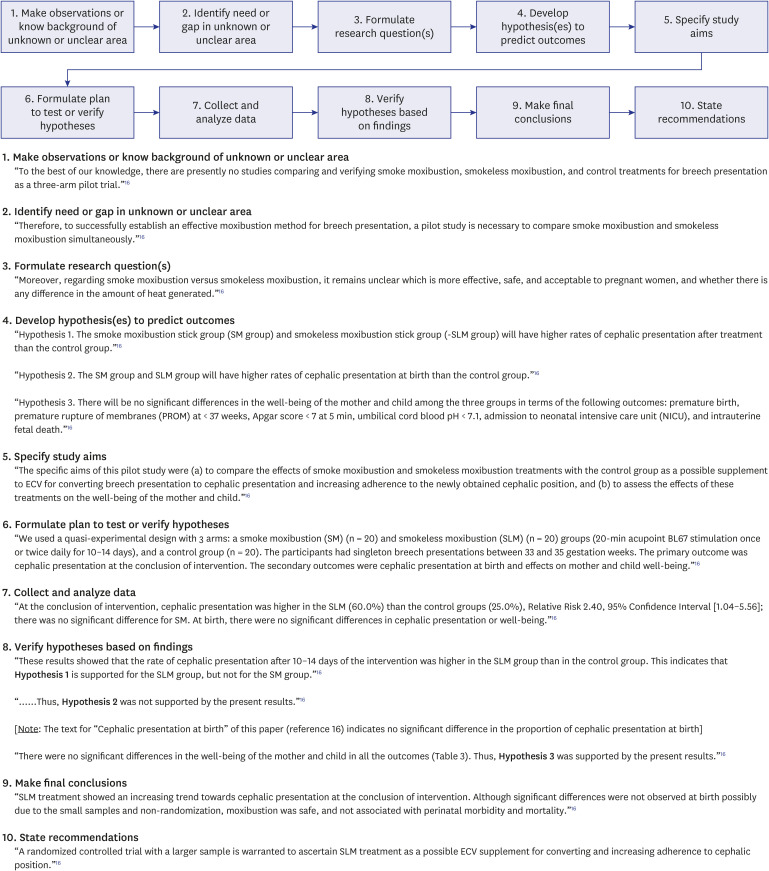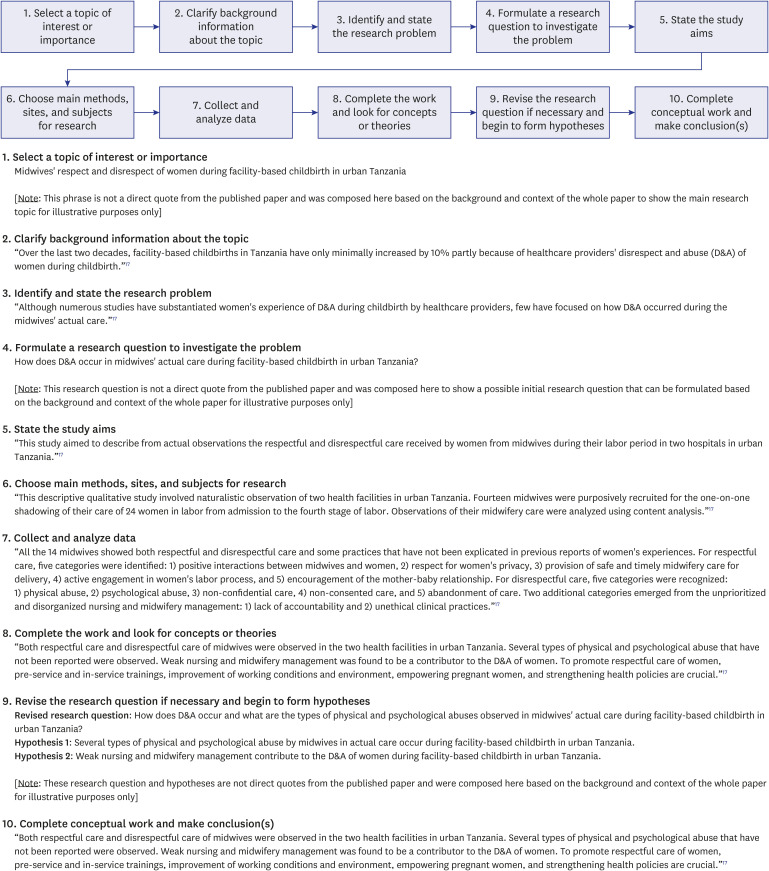J Korean Med Sci.
2022 Apr;37(16):e121. 10.3346/jkms.2022.37.e121.
A Practical Guide to Writing Quantitative and Qualitative Research Questions and Hypotheses in Scholarly Articles
- Affiliations
-
- 1Department of General Education, Graduate School of Nursing Science, St. Luke’s International University, Tokyo, Japan
- 2Department of Biological Sciences, Messiah University, Mechanicsburg, PA, USA
- KMID: 2529289
- DOI: http://doi.org/10.3346/jkms.2022.37.e121
Abstract
- The development of research questions and the subsequent hypotheses are prerequisites to defining the main research purpose and specific objectives of a study. Consequently, these objectives determine the study design and research outcome. The development of research questions is a process based on knowledge of current trends, cutting-edge studies, and technological advances in the research field. Excellent research questions are focused and require a comprehensive literature search and in-depth understanding of the problem being investigated. Initially, research questions may be written as descriptive questions which could be developed into inferential questions. These questions must be specific and concise to provide a clear foundation for developing hypotheses. Hypotheses are more formal predictions about the research outcomes. These specify the possible results that may or may not be expected regarding the relationship between groups. Thus, research questions and hypotheses clarify the main purpose and specific objectives of the study, which in turn dictate the design of the study, its direction, and outcome. Studies developed from good research questions and hypotheses will have trustworthy outcomes with wide-ranging social and health implications.
Figure
Reference
-
1. Research.com. How to write a research question: Types, steps, and examples. Updated 2021. Accessed January 2, 2022. https://research.com/research/how-to-write-a-research-question .2. Chigbu UE. Visually hypothesising in scientific paper writing: confirming and refuting qualitative research hypotheses using diagrams. Publications. 2019; 7(1):22.3. International Institute of Health Sciences. Developing hypothesis and research question. Updated 2022. Accessed January 3, 2022. https://www.iihs.edu.lk/mod/resource/view.php?id=34513&forceview=1 .4. Excelsior College. Research hypotheses. Updated 2022. Accessed February 3, 2022. https://owl.excelsior.edu/research/research-hypotheses/ .5. Wordvice. How to write a hypothesis or research question. Updated 2021. Accessed January 4, 2022. https://blog.wordvice.com/how-to-write-a-hypothesis-or-research-question/ .6. Gasparyan AY, Ayvazyan L, Mukanova U, Yessirkepov M, Kitas GD. Scientific hypotheses: writing, promoting, and predicting implications. J Korean Med Sci. 2019; 34(45):e300. PMID: 31760713.7. Misra DP, Gasparyan AY, Zimba O, Yessirkepov M, Agarwal V, Kitas G. Formulating hypotheses for different study designs. J Korean Med Sci. 2021; 36(50):e338. PMID: 34962112.8. SCIENCING. Difference between proposition and hypothesis. Updated 2017. Accessed January 5, 2022. https://sciencing.com/requirements-scientific-hypothesis-12010671.html .9. Misra DP, Agarwal V. Generating working hypothesis for original research studies. Cent Asian J Med Hypotheses Ethics. 2020; 1(1):14–19.10. PRESSBOOKS. Developing a hypothesis. Updated 2022. Accessed January 6, 2022. https://opentext.wsu.edu/carriecuttler/chapter/developing-a-hypothesis/ .11. STUDYANDEXAM. Hypothesis. Updated 2022. Accessed January 6, 2022. https://www.studyandexam.com/hypothesis.html .12. Farrugia P, Petrisor BA, Farrokhyar F, Bhandari M. Practical tips for surgical research: Research questions, hypotheses and objectives. Can J Surg. 2010; 53(4):278–281. PMID: 20646403.13. PRESSBOOKS. Scientific inquiry in social work. Inductive and deductive reasoning. Updated 2022. Accessed January 7, 2022. https://scientificinquiryinsocialwork.pressbooks.com/chapter/6-3-inductive-and-deductive-reasoning/ .14. Ratan SK, Anand T, Ratan J. Formulation of research question – Stepwise approach. J Indian Assoc Pediatr Surg. 2019; 24(1):15–20. PMID: 30686882.15. Creswell J. Research Design: Qualitative, Quantitative, and Mixed Methods Approaches. 3rd ed. Los Angeles, CA, USA: SAGE;2009.16. Higashihara A, Horiuchi S. Smoke or smokeless moxibustion treatment for breech presentation: a three-arm pilot trial. Jpn J Nurs Sci. 2021; 18(4):e12426. PMID: 33999503.17. Shimoda K, Horiuchi S, Leshabari S, Shimpuku Y. Midwives’ respect and disrespect of women during facility-based childbirth in urban Tanzania: a qualitative study. Reprod Health. 2018; 15(1):8. PMID: 29321051.18. Bhasin H. What is a research hypothesis and how to write it? Updated 2020. Accessed January 7, 2022. https://www.marketing91.com/research-hypothesis/ .19. Wang X, Jehi L, Ji X, Mazzone PJ. Phenotypes and subphenotypes of patients with COVID-19: a latent class modeling analysis. Chest. 2021; 159(6):2191–2204. PMID: 33640378.20. Taneda K, Mani H, Kato N, Komizunai S, Ishikawa K, Maruya T, et al. Effects of simulated peripheral visual field loss on the static postural control in young healthy adults. Gait Posture. 2021; 86:233–239. PMID: 33774584.21. Vizza CD, Hoeper MM, Huscher D, Pittrow D, Benjamin N, Olsson KM, et al. Pulmonary hypertension in patients with COPD. Chest. 2021; 160(2):678–689. PMID: 33581097.22. Roberts KJ, Binns HJ, Vincent C, Koenig MD. A scoping review: family and child perspectives of clinic-based obesity treatment. J Pediatr Nurs. 2021; 57:56–72. PMID: 33271477.23. Kaminishi K, Chiba R, Takakusaki K, Ota J. Increase in muscle tone promotes the use of ankle strategies during perturbed stance. Gait Posture. 2021; 90:67–72. PMID: 34411975.24. Jamerson BD, Haryadi TH. The use of ibuprofen to treat fever in COVID-19: a possible indirect association with worse outcome? Med Hypotheses. 2020; 144:109880. PMID: 32505846.25. Hollar SM, Siegel JT. Self-distancing as a path to help-seeking for people with depression. Soc Sci Med. 2020; 245:112700. PMID: 31835196.26. Trzeciak S, Roberts BW, Mazzarelli AJ. Compassionomics: hypothesis and experimental approach. Med Hypotheses. 2017; 107:92–97. PMID: 28915973.27. Hayashi W, Suzuki H, Saga N, Arai G, Igarashi R, Tokumasu T, et al. Clinical characteristics of women with ADHD in Japan. Neuropsychiatr Dis Treat. 2019; 15:3367–3374. PMID: 31824160.28. Oka M, Horiuchi S, Shimpuku Y, Madeni F, Leshabari S. Effects of a job aid-supported intervention during antenatal care visit in rural Tanzania. Int J Africa Nurs Sci. 2019; 10:31–37.29. Sonoda N, Takahata K, Tarumi W, Shinohara K, Horiuchi S. Changes in the cortisol and oxytocin levels of first-time pregnant women during interaction with an infant: a randomized controlled trial. BMC Pregnancy Childbirth. 2021; 21(1):162. PMID: 33627086.30. Shimpuku Y, Madeni FE, Horiuchi S, Kubota K, Leshabari SC. A family-oriented antenatal education program to improve birth preparedness and maternal-infant birth outcomes: a cross sectional evaluation study. Reprod Health. 2019; 16(1):107. PMID: 31311563.
- Full Text Links
- Actions
-
Cited
- CITED
-
- Close
- Share
- Similar articles
-
- Conducting and Writing Quantitative and Qualitative Research
- Scientific Hypotheses: Writing, Promoting, and Predicting Implications
- Qualitative Research in Healthcare: Necessity and Characteristics
- Improving Scientific Writing Skills and Publishing Capacity by Developing University-Based Editing System and Writing Programs
- Literature Analysis on Reporting Standards for Qualitative Research in Cancer-related Studies




